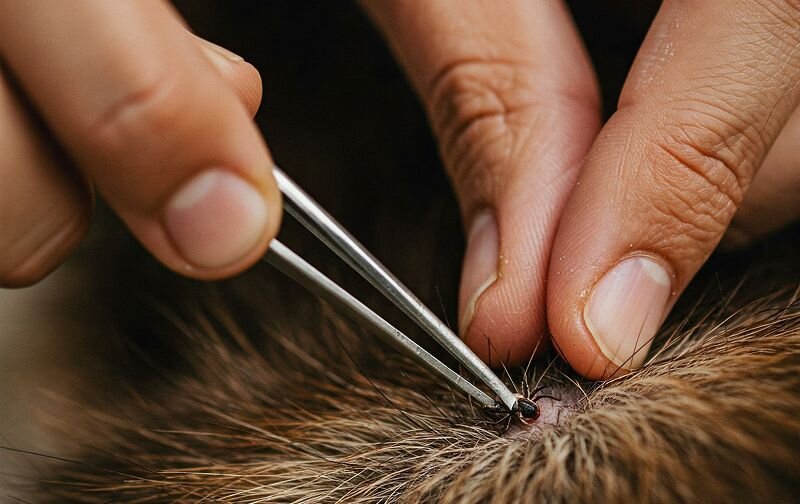Last Updated: 28/07/2025
Identifying Paralysis Ticks On Dogs & Cats
Interested in knowing more about tick paralysis in dogs and cats? Read more about preventatives and what to do if you find a tick on your pet.
Author: Dr Teagan Lever BVSc (Hons)
Reading Time: 6 minutes - short read
Tick paralysis is a serious and potentially fatal condition that affects pets in Australia. It is caused by a toxin produced by the paralysis tick, a small, blood-sucking parasite that is commonly found in coastal and rural areas.
Early detection and treatment are crucial in preventing the fatal consequences of tick paralysis. If you suspect your pet may have been bitten by a tick or is exhibiting any of the symptoms of tick paralysis, do not hesitate to contact your veterinarian.
Read on to learn more about tick paralysis and how to protect your pet.
What is Tick Paralysis?

Tick paralysis is a potentially fatal condition caused by the paralysis tick Ixodes holocyclus, which can affect dogs, cats and other animal species.
Tick paralysis occurs when one or many paralysis ticks attach themselves to the animals skin and begin feeding on their blood, while releasing a deadly toxin in their saliva. This toxin affects the animals nervous system, resulting in gradual ascending paralysis.

There are three main tick species that affect pets in Australia: The Brown Tick, Bush Tick and Paralysis Tick. Bush Ticks are usually not life threatening but may irritate your dog where they latch on to feed. The Brown Dog Tick, while not harmful itself, can transmit tick-borne diseases such as Ehrlichiosis, a bacterial disease that recently occurred in Australia. Paralysis Ticks however, are the major concern in Australia as they can be deadly.
Paralysis Ticks are commonly found along the east coast of Australia, from north Queensland to east Victoria. Paralysis Ticks are of concern year-round but are more prevalent in the warmer months of Spring and Summer.
Paralysis ticks can vary in size and colour, making identification challenging. They can range from light grey to a bluish colour when fully engorged and they have an orange head and eight legs at the front of their body. The two front and back legs are significantly darker in colour than the two middle pairs.
Looking for more information on Ehrlichiosis? Read our veterinary written article Ehrlichiosis in Australian Dogs.
What Are The Symptoms of Tick Paralysis?

Early symptoms of tick paralysis in dogs and cats can include altered vocal sounds, hindlimb weakness and reduced or absent blink and swallow reflexes, sometimes resulting in regurgitation of food or water. Often times pets in the early stages of paralysis show only one or two symptoms to begin with.
Signs of Tick Paralysis:
- Weakness or Loss of Coordination in Back Legs
- Change in sound of Bark or Voice
- Loss of Appetite
- Drooling
- Trouble Breathing
- Coughing
- Vomiting, Retching and Regurgitation
As the toxin continues to spread throughout the body, it begins to cause paralysis of the hindlimbs which ascends to the forelimbs and eventually progresses to complete paralysis. The muscles of respiration are also affected, making it more and more difficult for the pet to breathe.
It is important to note that every animal is affected differently by paralysis tick toxin, so not all of the symptoms listed may be apparent in each case.
How is Tick Paralysis Treated?

Tick paralysis in dogs and cats can be treated by administering a tick antitoxin. The tick antitoxin works by binding any toxin that is still circulating in the blood, slowing the progression of the symptoms. Unfortunately, it can not remove the toxin already bound to the nervous system, which takes time to neutralise.
This is why most pets require hospitalisation and intensive supportive care as part of their tick treatment. In complicated or severe cases where paralysis of the lungs occur, intensive care including oxygen supplementation or even artificial ventilation may be required. Tick treatment is far from simple, is not always effective and holds a guarded prognosis. The average cost of tick paralysis treatment can be around $2000, although it is not uncommon for treatment for more severe cases to cost in excess of $10,000. Pet parents with pet insurance should be sure to check if their policy has any sublimits for treatment of tick paralysis, as many will only cover treatment for up to a few thousand dollars. Pet Circle Insurance has no sneaky sublimits, meaning the pet is covered for tick paralysis treatment up to their total annual limit.
How to Protect Your Pet From Tick Paralysis

When it comes to tick protection, prevention is better than cure! Prevention of tick paralysis involves being aware of your pet's risk of exposure, daily tick searches and the use of an effective tick preventative treatment.
Many pet owners who live in areas with high levels of paralysis tick activity prefer to have their long haired pet's coats shaved or cut very short to make regular tick searching easier. If you have a cat, consider keeping them indoors; you'll not only be keeping them safe from paralysis ticks but other dangers such as snakes, cars and cat fights too!
For Dogs:
With the availability of highly effective, newer generation oral flea and tick treatments such as Nexgard, Simparica and Bravecto, many veterinarians now class tick paralysis as a preventable in dogs.
This highly effective tick prevention is also available in combined products such as Nexgard Spectra, Simparica Trio and Credelio Plus which include coverage for intestinal worms and heartworm. These preventatives work by disrupting the ticks nervous system, leading to death. Older products such as shampoos work by repelling the ticks and are not always effective.
If oral treatments are not an option for your dog, never fear! Bravecto Spot On for Dogs covers your dog for ticks and fleas for 6 whole months with each application. Alternatively you can use a tick collar such as Seresto which is effective for 8 months against paralysis ticks.
For Cats:
There are a range of, easy-to-use tick prevention products now available for cats including: Bravecto Spot On for Cats, Bravecto Plus, Revolution Plus and NexGard Spectra Spot-On for Cats.
What if paralysis ticks aren't a risk in your area? There are certain parts of Australia, including Perth and Adelaide, where paralysis ticks are not found. However, Brown Dog Ticks may be a risk for dogs in these areas. Brown dog ticks can carry and transmit Ehrlichia canis, a disease which can be fatal to dogs. For dogs in these areas, our recommendation is to use a Seresto collar which controls Brown dog ticks and reduces the chance of transmission of Ehrlichia for 4 months, along with an oral tick preventative such as Nexgard, Bravecto, Credelio or Simparica. While Brown dog ticks pose minimal risk to cats, if you live in an area where Brown Dog ticks are active, we recommend speaking to your vet regarding additional tick control for your cat.
What To Do If You Find a Paralysis Tick On Your Pet

If you think you have found a paralysis tick on your pet, the first step is to carefully try and remove it.
When removing, do not put pressure on the tick, as pressing on or rupturing the tick during removal can force additional toxins into your pet. If you are not confident in your ability to remove the tick seek immediate veterinary assistance.
The easiest and least painful method to remove a tick is to use a Tick Twister. This tool allows you to get under the tick's head to remove the entire parasite easily in one go. Tick Twisters are a handy addition to your Pet First Aid Kit.
Once you have removed the tick from your pet, seek immediate veterinary attention. Even if your pet is not showing signs of tick paralysis initially, symptoms could still develop as the toxin can remain active in the body for some time after the tick's removal.
Remember to take the removed tick with you to the vet so that they can identify if it is a paralysis tick. There are other varieties of tick present in Australia which do not secrete the same deadly toxin.
Want to know more? Check out our article on How to Remove Ticks from Pets.
Prevention is better than cure! Know the symptoms of tick paralysis, keep your pet's preventative treatments up to date and check for ticks daily as no medication is 100% effective at all times.
Remember that if you find a tick on your pet, or if they are showing signs of tick paralysis seek veterinary attention without delay. Tick paralysis is frequently fatal without treatment and the earlier treatment can be provided the better the prognosis.
History
Our experts continually monitor the health and wellness space and we update our articles when new information becomes available.
Fri 14 Jan 2020
Written by Dr Teagan Lever BVSc (Hons)Dr Teagan Lever BVSc (Hons)
Head Veterinarian, BVSc (Hons)
Pet Circle's Head Veterinarian, Dr Teagan graduated from the University of Queensland in 2010 and went on to work in small animal and mixed practice in various locations around QLD & ACT before joining Pet Circle in early 2016. Dr Teagan has special interests in dermatology, nutrition and preventative health care. She feels privileged to witness the special bond people share with their pets on a daily basis and enjoys forming lasting relationships with pet parents and their fur children.

